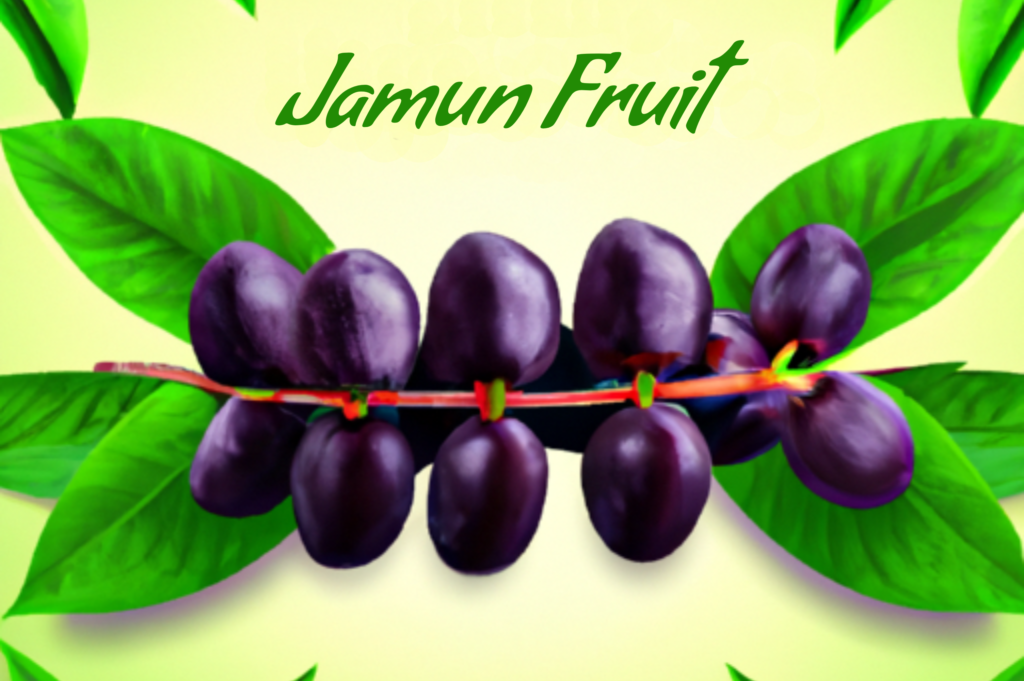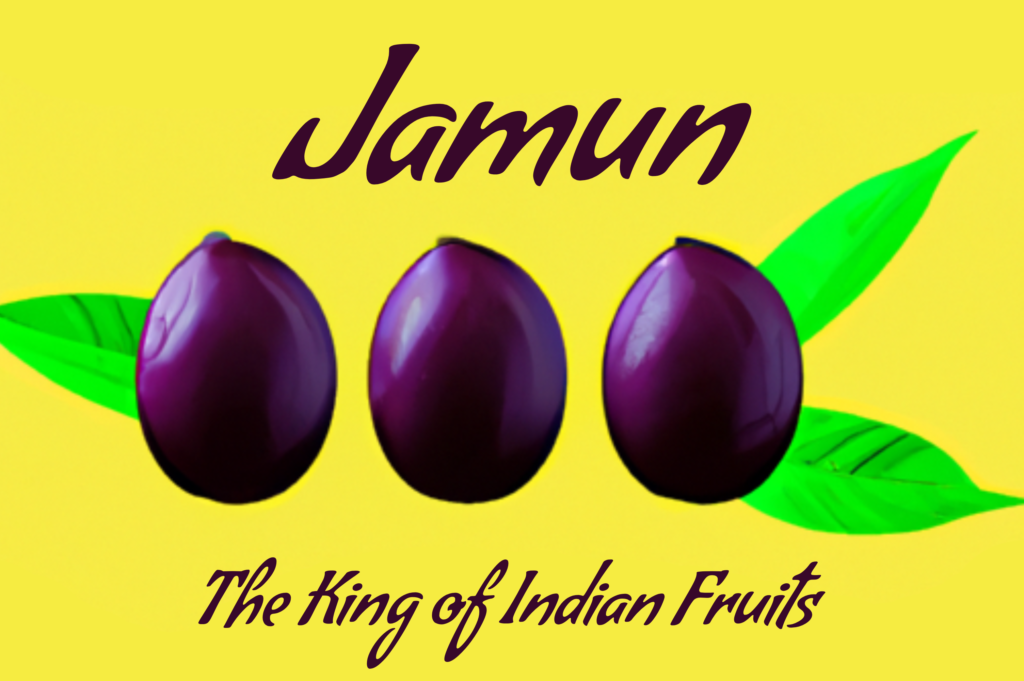In this article, you will learn about the jamun fruit in english, also known as the King of Indian Fruits. You might be wondering what makes this fruit so special and why it has earned such a royal title. Well, get ready to be amazed as we delve into the unique qualities and benefits of this delicious fruit.
Jamun fruit in english, also known as black plum, is a small purple fruit that is native to India. It has a sweet and tangy taste, making it a favorite among locals. But it’s not just its taste that makes jamun special. This fruit is packed with antioxidants and nutrients that can provide numerous health benefits, such as improving digestion, boosting immunity, and even helping to manage diabetes. So get ready to discover the wonders of jamun and why it truly deserves its royal title.

Jamun: The King of Indian Fruits
Jamun, also known as Indian blackberry or Java plum, is a delicious and nutritious fruit that holds a special place in Indian culture. With its deep purple hue, tangy flavor, and numerous health benefits, jamun has become a favorite among Indians. In this article, we will explore the physical description, origins, cultural significance, nutritional value, culinary uses, medicinal properties, and various other aspects of jamun.
Physical Description
Jamun is a small-sized fruit that grows on evergreen trees known as Syzygium cumini. The fruit is oval-shaped and typically measures around 2-3 centimeters in diameter. The skin of the fruit is smooth and glossy, ranging in color from dark purple to almost black. Inside, the fruit has a juicy and flavorful flesh that is both sweet and tart. It also contains a seed that is usually discarded before consuming the fruit.
Origins and Distribution
Jamun is native to the Indian subcontinent and has been grown for centuries. It is believed to have originated in the Gangetic plains of India and has since spread to various parts of Southeast Asia. Today, it is widely grown in countries like India, Bangladesh, Sri Lanka, and Indonesia. The fruit is seasonal, with the peak harvesting season occurring during the summer months.
Cultural Significance
In Indian culture, jamun holds a special place in various aspects of life. It is not just a fruit but also a symbol of prosperity and well-being. Jamun trees are often planted in temple courtyards and are considered sacred. The fruit is associated with Lord Shiva and is offered to him during prayers and rituals. Its deep purple color is also associated with the divinity and is considered auspicious.
Nutritional Value of Jamun
Jamun is not only a delicious fruit but also packed with essential vitamins and minerals. It is a rich source of vitamin C, which helps boost immunity and promotes healthy skin. The fruit is also high in iron and is beneficial for individuals with iron-deficiency anemia. Additionally, jamun contains significant amounts of calcium, potassium, and fiber. It is a low-calorie fruit, making it an ideal snack for those watching their weight.
Health Benefits
The nutritional composition of jamun contributes to its numerous health benefits. The high vitamin C content helps to strengthen the immune system and protect the body against various infections and diseases. The fruit’s iron content helps in the production of red blood cells and prevents anemia. The presence of dietary fiber aids in digestion and promotes a healthy digestive system. Some studies have also suggested that jamun may have anti-diabetic properties and can help regulate blood sugar levels.

Culinary Uses of Jamun
In addition to its health benefits, jamun also finds its way into various culinary creations, both traditional and modern.
Traditional Indian Recipes
In India, jamun is a popular fruit that is often used to make traditional recipes. One of the most common uses is in the preparation of jamun juice. The dark purple fruit is juiced, mixed with water and sugar, and then served chilled. It is a refreshing and cooling drink during the hot summer months. Jamun is also used to make jams, jellies, and preserves, which are enjoyed with bread or as a topping on desserts like ice cream.
Modern Culinary Innovations
In recent years, chefs and food enthusiasts have started experimenting with jamun in various modern dishes. The fruit’s unique flavor profile and rich color make it an excellent ingredient for desserts, salads, and even savory dishes. Jamun finds its way into a variety of delicious creations, including jams, sauces, and syrups that beautifully complement pancakes, waffles, and yogurt. Due to its tanginess and vibrant color, many people enjoy adding jamun to salads for an extra burst of flavor. Additionally, it serves as a delightful ingredient in chutneys and relishes, enhancing the taste of main dishes and snacks.
Jamun Tree and Plant
Understanding the characteristics of the jamun tree helps in understanding its cultivation and maintenance.
Tree Characteristics
The jamun tree is an evergreen tree that can reach a height of up to 30 meters. It has a dense crown with oblong leaves that are about 10-12 centimeters in length. The tree blooms with fragrant white flowers, which attract bees and butterflies. After pollination, the flowers give way to small green fruits that gradually turn purple-black as they ripen. The trees are known for their ability to withstand harsh weather conditions and are well-adapted to tropical climates.
Cultivation and Maintenance
Jamun trees are typically grown from seeds or through grafting. The trees require well-drained soil and plenty of sunlight to thrive. They are relatively low maintenance, requiring regular watering and occasional pruning. The trees bear fruit after around 5-7 years of planting, and once established, they can produce fruit for several decades. Jamun trees are often found in backyards and gardens in India and are cherished for their beautiful foliage and delicious fruit.
Medicinal Properties of Jamun
Jamun has long been used in traditional Ayurvedic medicine for its numerous medicinal properties.
Traditional Uses in Ayurveda
According to Ayurvedic principles, jamun possesses several medicinal properties. Many people believe that jamun exhibits a cooling effect on the body, making it a widely used remedy to relieve symptoms of heat-related illnesses such as sunstroke and dehydration. Moreover, the fruit possesses astringent properties that aid in treating diarrhea and dysentery. People use jamun leaves as a poultice or paste to treat skin conditions like acne and inflammation.
Modern Scientific Studies
Modern scientific research has also shed light on the potential health benefits of jamun. Several studies have suggested that jamun exhibits anti-inflammatory and antioxidant properties, which can help in reducing oxidative stress and preventing chronic diseases. The fruit’s high anthocyanin content, responsible for its purple color, has shown potential in reducing the risk of heart disease and improving overall cardiovascular health. Jamun has also shown anti-cancer properties in lab studies, although further research is needed to explore its full potential in this area.
Jamun in Indian Culture
This fruit holds a significant place in Indian culture and is associated with various religious and mythological associations.
Religious and Mythological Associations
According to Hindu mythology, Lord Shiva consumed a handful of jamun fruit following a deep meditation. The fruit holds a symbol of divinity, frequently linked to Lord Shiva’s benevolence and spiritual power. Devotees believe that jamun holds a special place in the heart of Goddess Durga, a revered deity in Hinduism. It is common practice to offer her this fruit during prayers and festive occasions. The deep purple color of jamun fruit is regarded as a representation of divinity in English and is frequently linked to auspicious occasions.
Folklore and Symbolism
In Indian folklore and traditions, jamun holds a special place. Regarded as a symbol of abundance, fertility, and prosperity, the fruit frequently takes part in wedding rituals and ceremonies, embodying good fortune and blessings. Moreover, people believe that planting jamun trees near homes and buildings invites good luck and prosperity. The bittersweet experiences of life often find metaphorical representation in literature and poetry through the tangy and sweet taste associated with the fruit.

Jamun Festivals and Celebrations
Jamun-related festivals and celebrations further highlight the cultural significance of this fruit in India.
Jamun-Related Festivals in India
In certain parts of India, festivals are celebrated to honor the arrival of the jamun fruit season. Various cultural activities, such as music, dance, and competitions, illuminate these festivals. One of these vibrant festivities is the “Jamun Mahotsav” celebrated in Allahabad, Uttar Pradesh, where people come together to savor the fruit and engage in communal feasts. The festival is a celebration of the joy and abundance that the jamun season brings.
Special Dishes and Customs
During the jamun season, special dishes and customs are observed in different regions of India. Certain states prepare a dish called “jamun-pani,” which involves soaking the fruit in water to enjoy its cooling and refreshing properties. Traditional sweets such as jamun kheer and jamun halwa incorporate the use of jamun in various regions. These dishes are enjoyed during festive occasions and family gatherings, showcasing the versatile culinary uses of jamun fruit in english.
Jamun Varieties
Jamun comes in different varieties and regional variations, each with its unique characteristics and flavors.
Different Types of Jamun
There are several types of jamun that vary in size, color, and taste. The most common variety is the “Java plum” (Syzygium cumini), which has a deep purple-black color and a sweet-tart flavor. Other varieties include the “Malabar plum,” which has a smaller size and a slightly sour taste, and the “Water apple” or “Rose apple,” which has a lighter purple color and a sweeter taste.
Regional Variations
Jamun also exhibits regional variations in different parts of India. In the state of Maharashtra, farmers cultivate a unique variety of jamun called “Maha Jamun,” which boasts large size and remarkable sweetness. In the state of Bihar, a jamun variety known as “Kala Jamun” is popular, which is smaller in size but extremely flavorful. These regional variations add to the diversity and richness of jamun in Indian cuisine.
Jamun in Traditional Medicine
Jamun fruit in english has been widely used in traditional medicine for centuries due to its therapeutic properties.
Jamun-Based Remedies
In Ayurveda, jamun has been used to treat various ailments. Therapeutic remedies are prepared using various forms of the jamun tree, including its fruit, leaves, and bark. For instance, people believe that jamun juice assists in managing conditions such as diabetes, while the utilization of jamun seed powder aids in treating digestive disorders and enhancing oral health. People utilize the bark of the jamun tree to treat fevers, inflammation, and respiratory conditions like asthma.
Jamun Products in the Market
With the increasing popularity of jamun, several jamun-based products have emerged in the market. These include jamun juice concentrates, jamun powder, and even jamun-infused beauty and skincare products. These products aim to offer the nutritional and medicinal benefits of jamun in a convenient and accessible form. However, it is essential to choose products from trusted sources and consult a healthcare professional before incorporating them into your routine.
Conclusion
Jamun, the King of Indian Fruits, holds a special place in Indian culture with its vibrant color, tangy taste, and numerous health benefits. From its physical description to its culinary uses, medicinal properties, and cultural significance, jamun is an integral part of Indian traditions and cuisine. As you delve into the wonders of this fruit, consider incorporating it into your diet and exploring its diverse flavors and benefits. By promoting the cultivation and consumption of jamun, we can ensure its preservation and continue to enjoy this regal fruit for generations to come. So go ahead and savor the taste of jamun fruit (in english), the King of Indian Fruits!

Hi, I’m King Phils, a Dragon Fruit enthusiast and blogger. Welcome to my website, where I share everything I know and love about this amazing fruit.